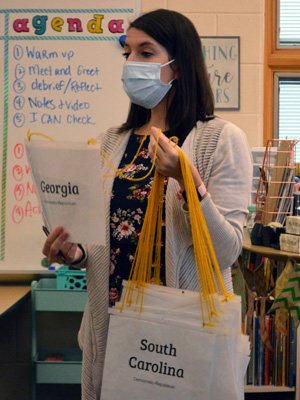Byron Center — At 3 cents an acre, the Louisiana Purchase is often called history’s greatest real-estate deal, and West Middle School eighth-graders recently considered its pros and cons while role-playing as senators.
“I do want to move forward with it, because I want the riverfront trading,” said Casey Schans, who represented a Georgia senator from the Democratic-Republican political party.

Though the purchase would double the size of the United States at the time, Federalists urged caution. It would expand slavery in new states and increase the power of the opposing party, students argued.
“I’m against it,” said Kalynn Rogers, playing a New Hampshire senator. Reasons: fear of expanding the U.S beyond current borders, and concerns that controlling the Mississippi River and New Orleans would lead to other conflicts.
Students in history teacher Rebecca Debowski’s class each represented a state in the meet-and-greet activity, which ultimately led to the two-thirds vote to purchase the land, which was approved as a treaty on April 30, 1803. (Third U.S. President Thomas Jefferson called it a treaty to get around the fact that buying land was not stated as a governmental power in the U.S. Constitution, and he was a strict Constitutionalist, Debowski explained.)
Students visited one another’s desks to learn about their stance on the purchase, then broke into groups to create a list of pros and cons. Four states – “swing votes” – eventually joined the pro side, sealing the deal for Thomas Jefferson.
“I think Jefferson might have enough votes to approve his treaty,” Debowski said.
Related Story: History curriculums around the world are in dire need of an update
Beyond Memorization and Timelines
Debowski is known for her U.S. history units that get students thinking, moving, asking questions and considering many sides of issues. Her interactive teaching helped earn her the 2022 Outstanding Teacher of American History from Holland’s Elizabeth Schuyler Hamilton chapter.
‘How do we teach critical thinking? How do we engage our children? How do we teach them historical empathy? It’s the how and that’s the part that everyone seems to be missing.’
— history teacher Rebecca Debowski
In her class, the wigged Founding Fathers, influential women and people of color from the past come to life through role-playing and activities that reveal the nuanced factors and issues that helped shape America.

Back in class, she explained the biggest issue behind deciding to move forward and accept Napoleon Bonaparte’s offer of a lifetime. While the Louisiana Purchase may seem like a no-brainer, those opposing it knew there would be huge repercussions.
“Why is slavery at the root of the Lousiana Purchase?” asked Debowski, who has been teaching at West Middle for eight years. “Why would the South be excited about getting more land? These are our plantation owners, these are our farmers, these are our people that need more land to do their jobs, to make money,” she said.
“Of course the South is going to be excited about this new land. It’s going to be these states that are going to be able to expand into that Louisiana territory, and what are they going to bring with them? Their slaves… The more slave states we add to the Union, the more they get to count their enslaved people for representation.”
The Democratic-Republicans would gain more power, resulting in the Federalists losing power, she said. “So, of course the Federalists are opposed to this.”
But, she cautioned, the Federalist’s reservations were much more about fear they would lose power than about being against slavery as an institution.
“We’ve got to understand it’s about political power,” she said. “It’s less to do with morals at this point than it is about power.”

‘Slavery is a part of history’
Debowski doesn’t gloss over issues that impacted America and its growth, even if they are controversial topics.
“History education is obviously in the news,” she said, referring to states’ proposals to limit how race, slavery and history are taught in America’s schools. “I teach the state standards, but in teaching the state standards, slavery is so much a part of decisions and politics.”
She focuses on how history can be taught. “How do we teach critical thinking? How do we engage our children? How do we teach them historical empathy? It’s the how and that’s the part that everyone seems to be missing.”
“Slavery is a part of our history, so we teach it, but how do we teach it? Through perspectives and empathy.”
She also uses it to show how it divided the country – decades before the Civil War. At the end of the recent class activity, she asked students to hold up the states they represented. “What are you noticing about these states?” she asked.
“They are all in the north or all in the south,” one student said.
“Look at the division that is already happening. We are divided south versus north, Federalist versus Democratic-Republican….The country is dividing, and it’s only 1803.”















